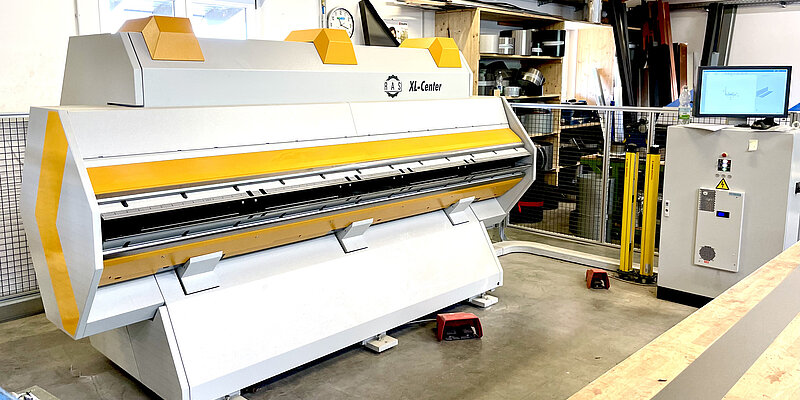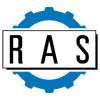To put it simply, capital equipment procurement is not as simple as buying your favorite snack from the grocery store. Since pieces of capital equipment are a major investment for your business, you need to make sure you find the right fit that will last for years. Because of this, it is crucial to plan for today and the future when going through the capital equipment purchasing process.
At RAS Systems, our high-quality folding and bending machines help your team boost productivity. However, finding the right fit requires research and preparation. As part of our commitment to help customers find the right machine to fit their unique fabrication needs, we’ve put together our top six steps to follow during capital equipment procurement. These steps are intended to help you make a more informed decision about the type of equipment you add to your roster.
1. Plan Ahead
The first step in capital equipment procurement is to prepare your own plan ahead of time. Before you begin the capital equipment purchasing process, be sure to research and select your desired machine, ensuring it meets your needs for automation, speed, and overall production.
Creating a plan before capital equipment procurement includes understanding several aspects of your business:
- Your Needs: What are they? What equipment will help you achieve them?
- Your Budget: How much can you spend on a piece of capital equipment? How much is allocated in the budget for this decision?
- Company Growth Plans: Where will this equipment take your company in the future? What changes or goals do you anticipate for your business with this purchase, and how can it help you succeed?
2. Test the Equipment
While you could go through the capital equipment procurement process without ever seeing your new machine, would that be the ideal scenario? Probably not. If you can, visit manufacturer events where your desired machines will be on display. Or, visit your supplier, where an on-site demo may be possible. This will allow you to see how your new equipment works and how it suits your business.
If you are not able to start the capital equipment purchasing process in person, you can always search for videos of your desired machine in action. At RAS, our YouTube channel gives you an up-close look at several of our industry-leading machines.
3. Determine What is Included in the Cost
Another key step of the capital equipment procurement process is analyzing the cost of each potential machine. Make sure the equipment has all the tools that you are looking for. If not, see if the manufacturer has a variety of models to choose from that can better suit your needs, or see if there are additional add-ons that can be included.
A new piece of equipment usually has a warranty of one year, and sometimes includes maintenance or service agreements for a certain period after purchase. Most equipment manufacturers also offer remote or in-person training for employees on their equipment. If this isn’t offered as part of your capital equipment purchasing process, request to pay for it to ensure optimal use of your capital purchase.
4. Consider Used Equipment
If budget is a concern for your business, you can always look for used pieces of capital equipment. For example, if you’re looking for a non-custom-built machine, buying used is often a good way to save money. Most equipment is built to last several years, so even if you’re buying a five-year-old machine, you can still have 10-15 years of use before it begins to wear down.
If purchasing used during capital equipment procurement, be sure to determine what warranties and/or service tools manufacturers offer, if any, and consider that in your purchase decision as well.

5. Determine How You Will Purchase Your Capital Equipment
Once you have a machine in your sights, it’s time to formalize your capital equipment procurement plan. Expensive capital equipment is not typically purchased with a single method. Determine where you will be getting the money for this equipment, such as government grants, loans, and leases, or financing your costs. Be aware of the pros and cons of each purchasing method before making your decision, and make sure your method supports your company in the long term.
6. Think of Your Business Future
The final step in capital equipment procurement is to think about the machine’s effects on your business down the road. In today’s tech-driven world, it’s important to find capital equipment with a digital base. Finding capital equipment that connects to your IoT can be an asset to your company as more progressive steps are made in technology.
Adding innovative software, such as our advanced products, keeps you ahead of your competitors and lets clients see you as a forward-thinking business.
If you follow these steps in the capital equipment purchasing process, you’ll set your business up for success when you find the right machine. Remember, proper planning can help you simplify capital equipment procurement, making your ultimate decision a little easier.
If you’re in the market for a new folding machine, contact our team today to see why leading companies across several industries have made the switch to RAS.
FAQs
What is capital equipment?
Capital equipment refers to long-term assets such as machinery, vehicles, or tools used in metal fabrication. These assets support business operations and typically provide value for more than one year.
What is a capital equipment purchase?
A capital equipment purchase is the acquisition of durable assets intended to support production or services over several years. These purchases are often high-cost and require proper planning.
How do I calculate ROI on capital equipment?
To calculate the ROI of your capital equipment procurement, divide the net benefits, including revenue or cost savings, by the overall price of your new machine. This will give you a percentage to express the financial return.
Is software considered capital equipment?
Software may be considered capital equipment if it’s purchased for long-term use, is a significant cost, and supports business operations.

Recent Comments